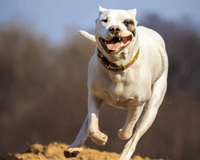Firstly, What is a Remote Training Collar?
A remote training collar is a device that helps with dog training by providing various types of stimuli, such as mild static correction, vibration, or sound to reinforce commands and correct unwanted behaviors. The system consists of a collar worn by the dog and a remote control held by the owner. When the dog follows a command or needs correction for bad behavior, the owner can send a signal using the remote. This immediate feedback makes training more effective. The collar is useful for teaching obedience, keeping the dog within certain boundaries, and addressing issues like excessive barking or jumping. It's important to use the collar correctly, following the manufacturer's instructions and reading our tips on how to use it!
15 Reasons Why Your Dog Would Benefit From a Remote Training Collar
Scenario 1: Running Away
Your dog loves to bolt whenever the gate is open. This puts them at risk of getting lost or injured. A remote training collar allows you to give an immediate correction if they start to run. This helps them understand the boundary of their territory. With consistent training, they'll learn to stay within the safe area of your garden.

Scenario 2: Aggressive Behaviour
Your dog shows aggression towards other dogs or people. This makes outings stressful and potentially dangerous. Using a remote training collar, you can interrupt aggressive behaviour with a corrective stimulus. This helps your dog learn that aggression is unacceptable. Over time, they can become calmer and more sociable, making walks and interactions more enjoyable.
Scenario 3: Ignoring Commands
Your dog often ignores basic commands like "sit" or "come." This lack of obedience can be frustrating and unsafe. A remote training collar provides reinforcement at the moment they disobey. This immediate feedback helps them understand and follow commands more reliably. Enhanced obedience makes for a better-behaved dog and a more relaxed owner. A great and easy option would be for our HW777 Remote Training Collar.
Scenario 4: Digging in the Garden
Your dog loves to dig holes all over your garden, ruining your landscaping. A remote training collar lets you correct this behaviour as it happens. You can stop the digging with a corrective signal. Consistent use will teach your dog to avoid this destructive habit, preserving your garden.
Scenario 5: Jumping on People
Your dog jumps on guests as soon as they enter your home. This can be off-putting and even dangerous. A remote training collar allows you to correct this behaviour immediately. You can teach your dog to greet guests calmly and politely. This makes visits more pleasant and safe for everyone.
Scenario 6: Chasing Cars or Animals
Your dog has a strong instinct to chase cars, bikes, or other animals. This is dangerous for both your dog and others. A remote training collar provides a way to stop the chase instantly. With consistent training, your dog will learn to resist the urge to chase, making walks safer.
Scenario 7: Overexcited Behaviour
Your dog gets overly excited in new environments, pulling on the lead and making walks unpleasant. A remote training collar can help calm them down. You can provide a corrective signal to help manage their excitement levels. This results in more enjoyable and controlled walks.

Scenario 8: Eating Unsafe Objects
Your dog tries to eat everything they find on walks, which could be harmful. A remote training collar helps you correct this dangerous behaviour on the spot. You can deliver a gentle correction when they go for something they shouldn't. This teaches them to avoid potentially toxic or harmful items.
Scenario 9: Excessive Barking
Your neighbour has complained about your dog's constant barking. It's disrupting their peace and causing friction. A remote training collar can help you train your dog to bark only when necessary. You can deliver a gentle static correction whenever they bark excessively. Over time, they'll associate barking with the correction and reduce the behaviour. This makes for a quieter neighbourhood and a happier relationship with your neighbours. Utilise our 2-in-1 Pro Anti-Bark and Remote Training Collar.
Scenario 10: Training for Advanced Skills
You want to teach your dog advanced skills or tricks. Basic obedience isn’t enough, and you need precise control. A remote training collar allows for clear and immediate communication. This helps reinforce complex commands and improves their learning process.
Scenario 11: Preparing for Competitions
You're preparing your dog for obedience or agility competitions. Consistency and precision in commands are crucial. A remote training collar ensures that your dog responds accurately and promptly. This level of discipline is essential for competitive performance.
Scenario 12: Managing Anxiety
Your dog has anxiety issues that lead to destructive behaviour, like chewing furniture. A remote training collar can be part of a broader training programme. You can use it to interrupt anxious behaviours and redirect their focus. Combined with positive reinforcement, it helps manage their anxiety more effectively.

Scenario 13: Enhancing Recall
Your dog has poor recall and doesn’t return when called, which is problematic in open spaces. A remote training collar provides an effective way to reinforce recall commands. A corrective signal when they don’t respond helps improve their recall ability. This makes off-lead activities safer and more enjoyable.
Scenario 14: Correcting Herding Behaviour
Your dog has strong herding instincts and tries to herd children or other pets. This can be disruptive and dangerous. A remote training collar can help you control and redirect this behaviour. You can provide immediate correction, teaching them to stop herding and focus on appropriate activities.
Scenario 15: House Training Issues
Your dog struggles with house training and often has accidents inside. A remote training collar can support house training efforts. You can correct them when they start to eliminate indoors. This immediate feedback helps them understand where it’s appropriate to go, speeding up the house training process.









